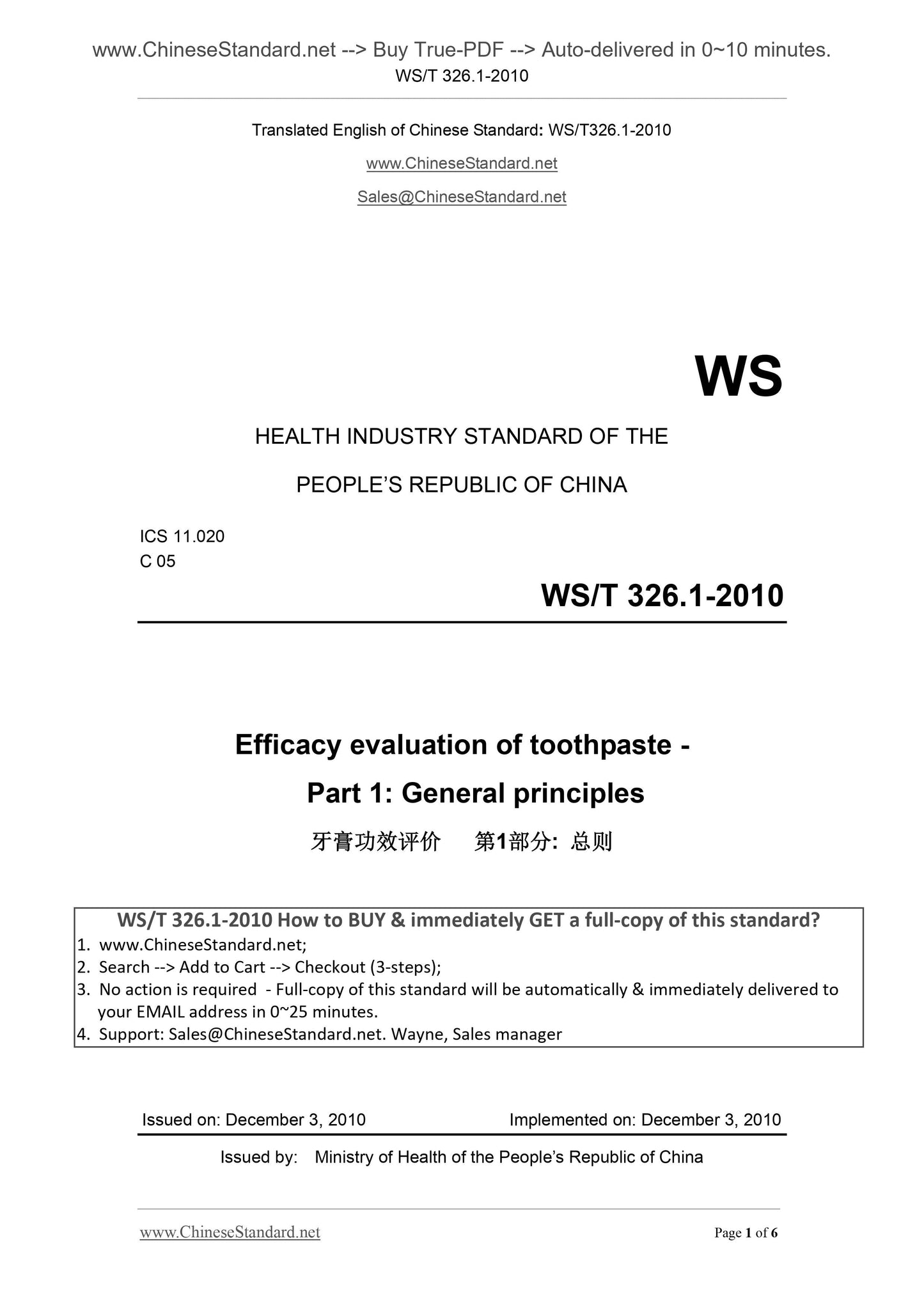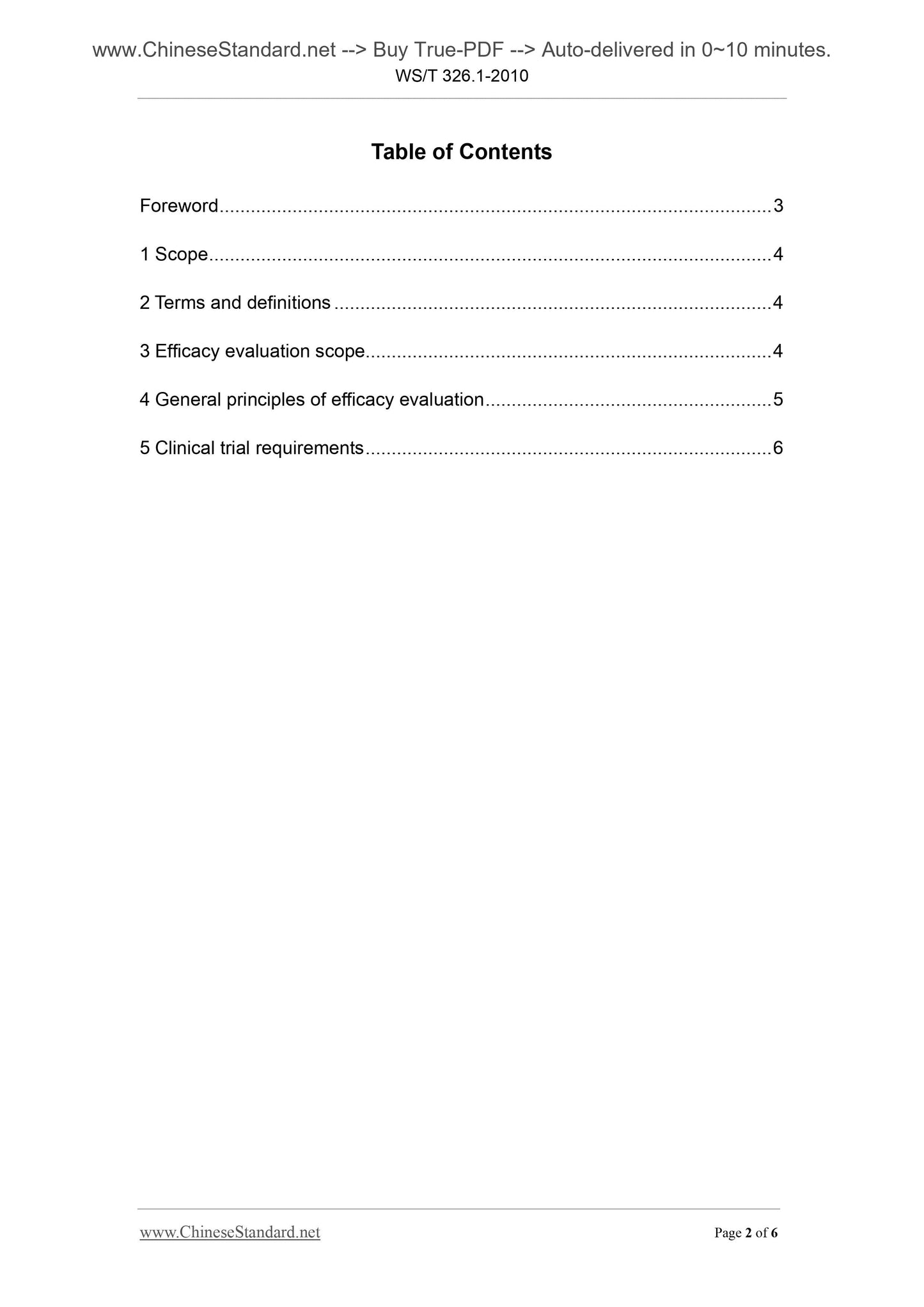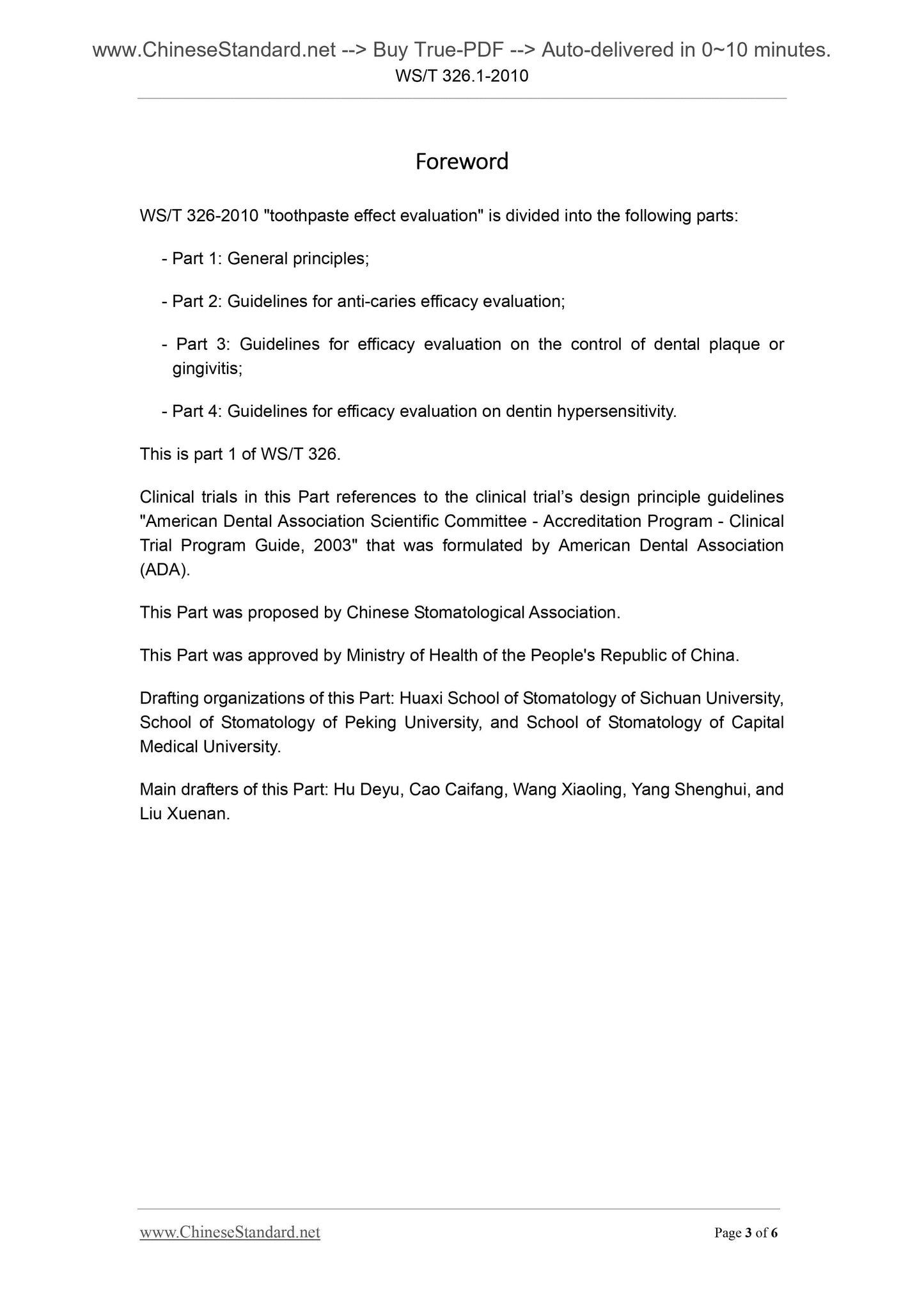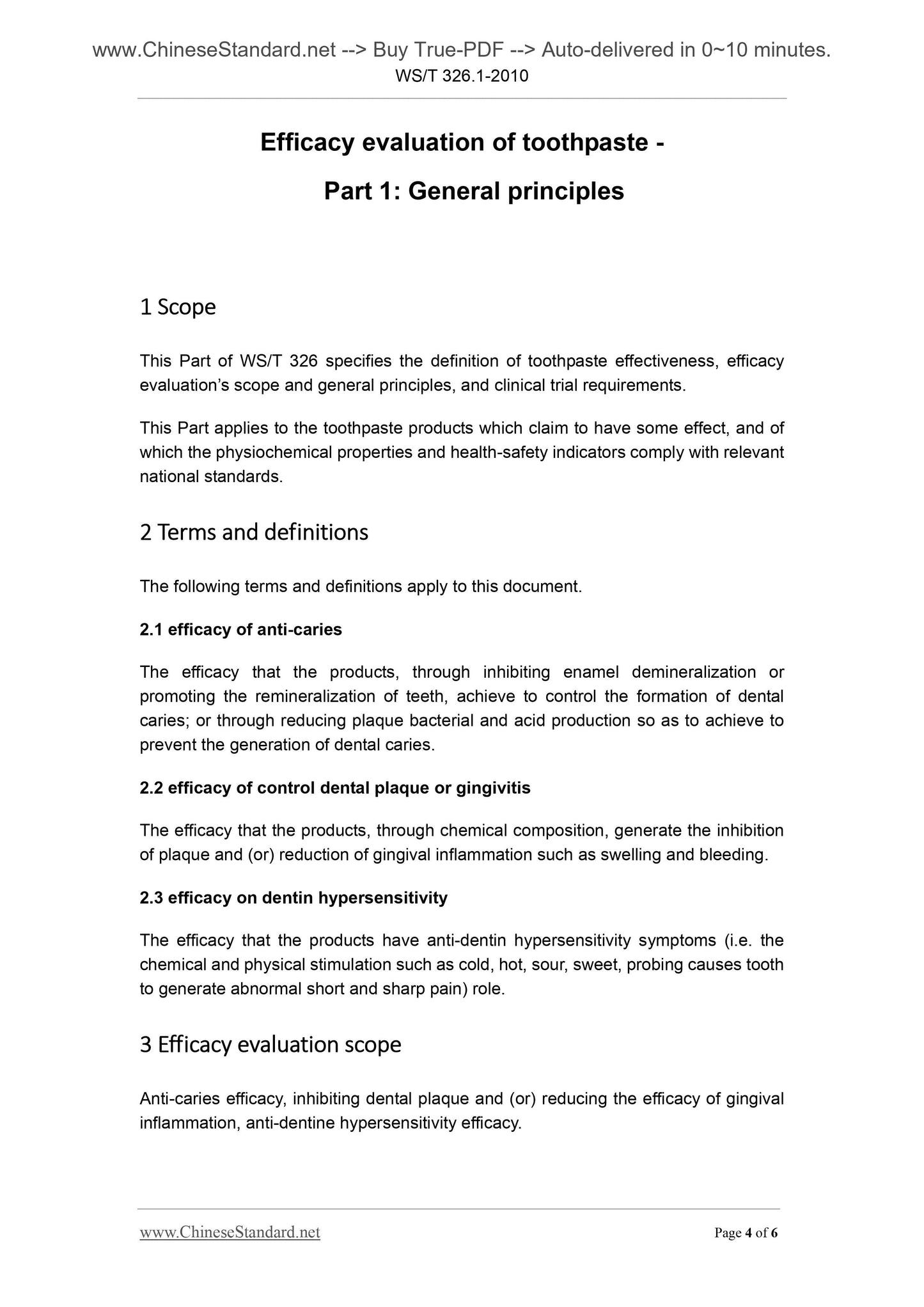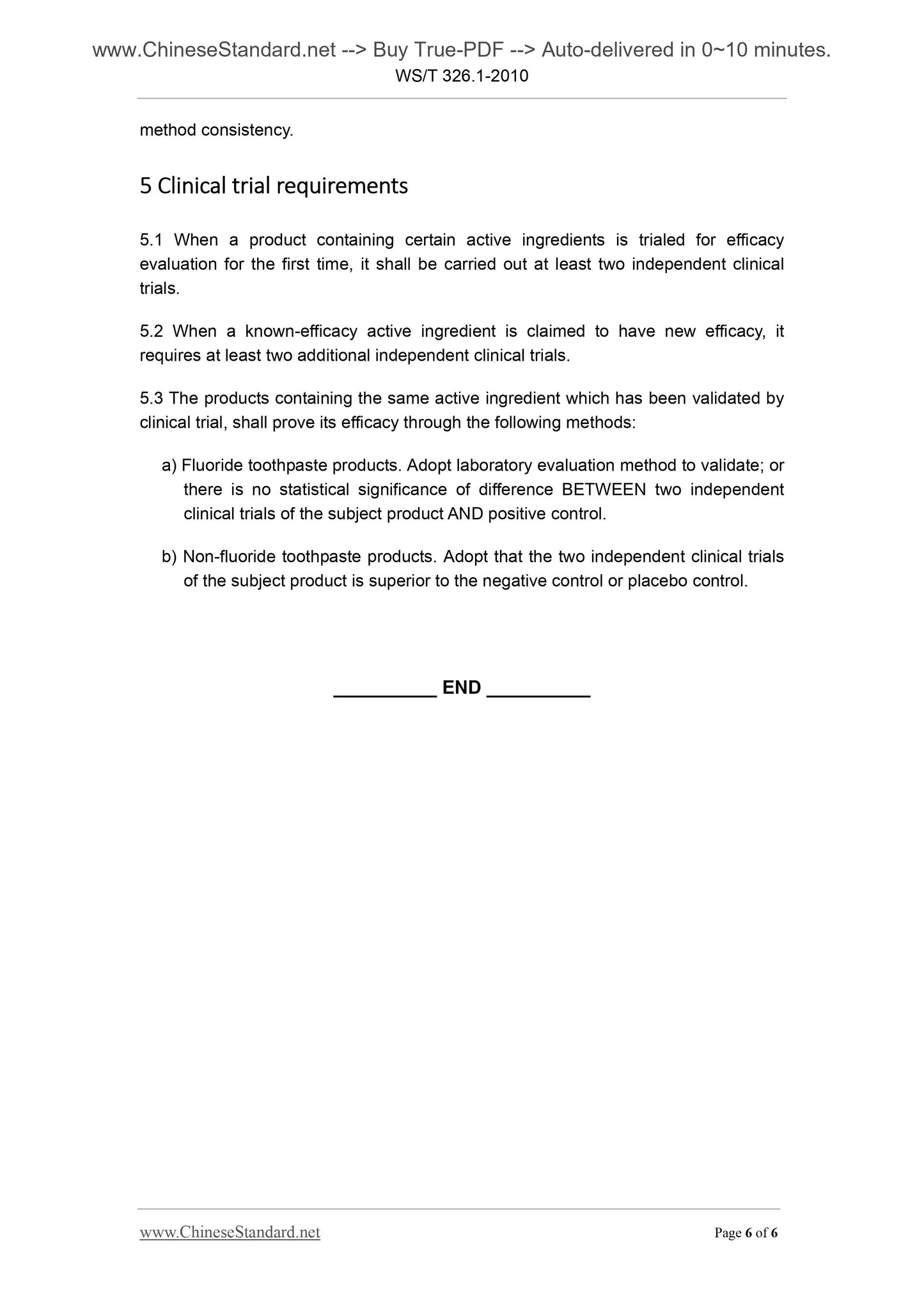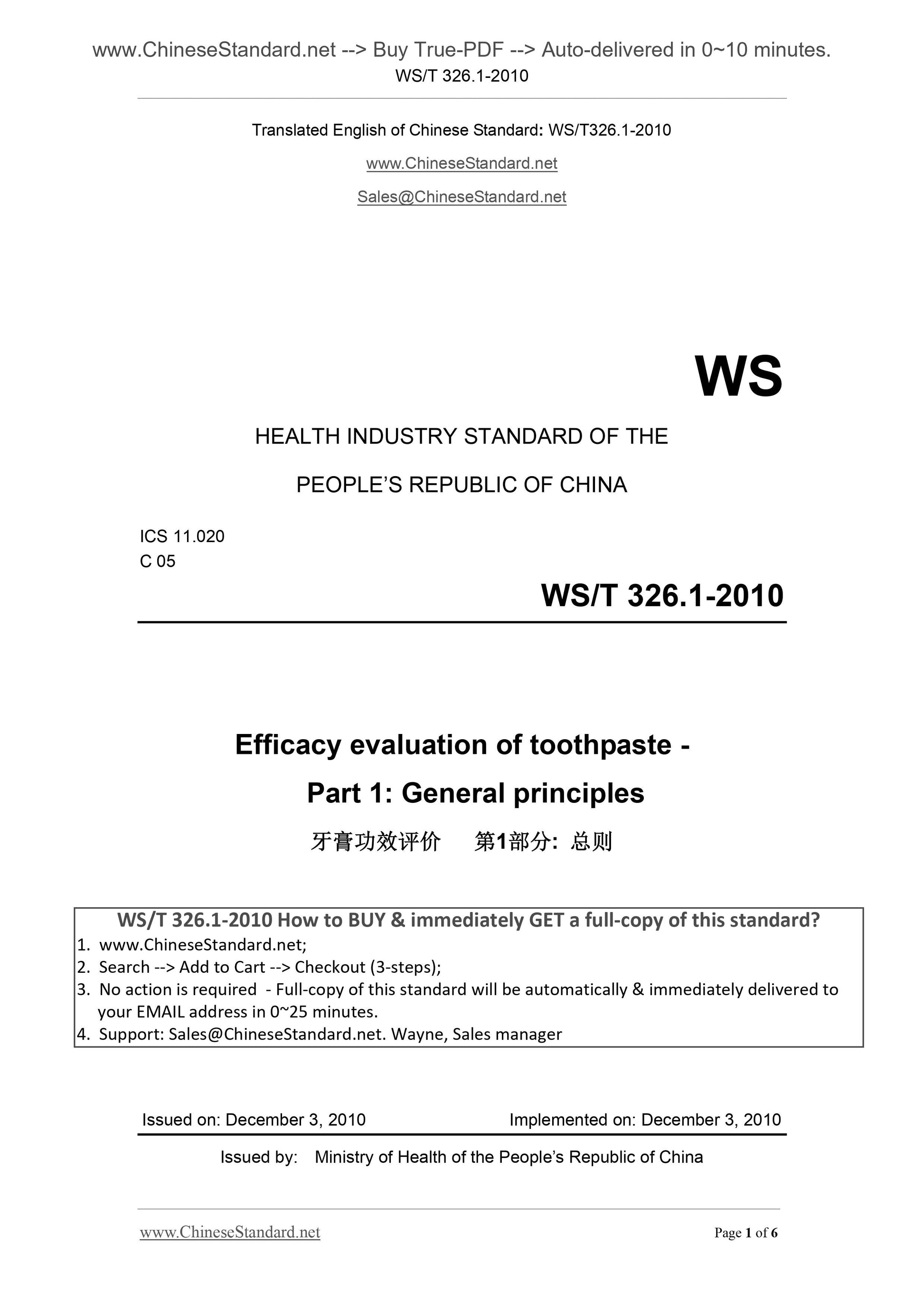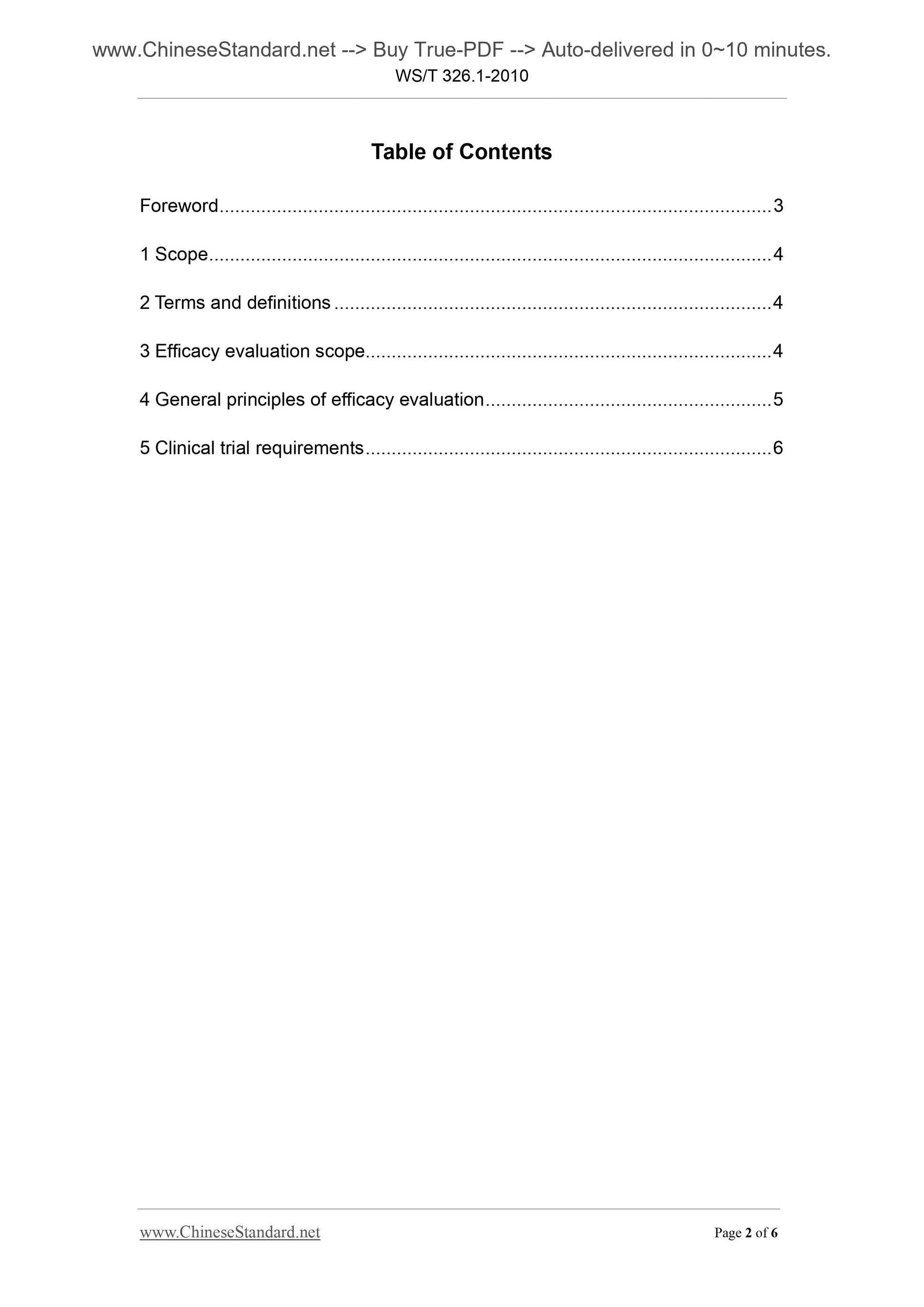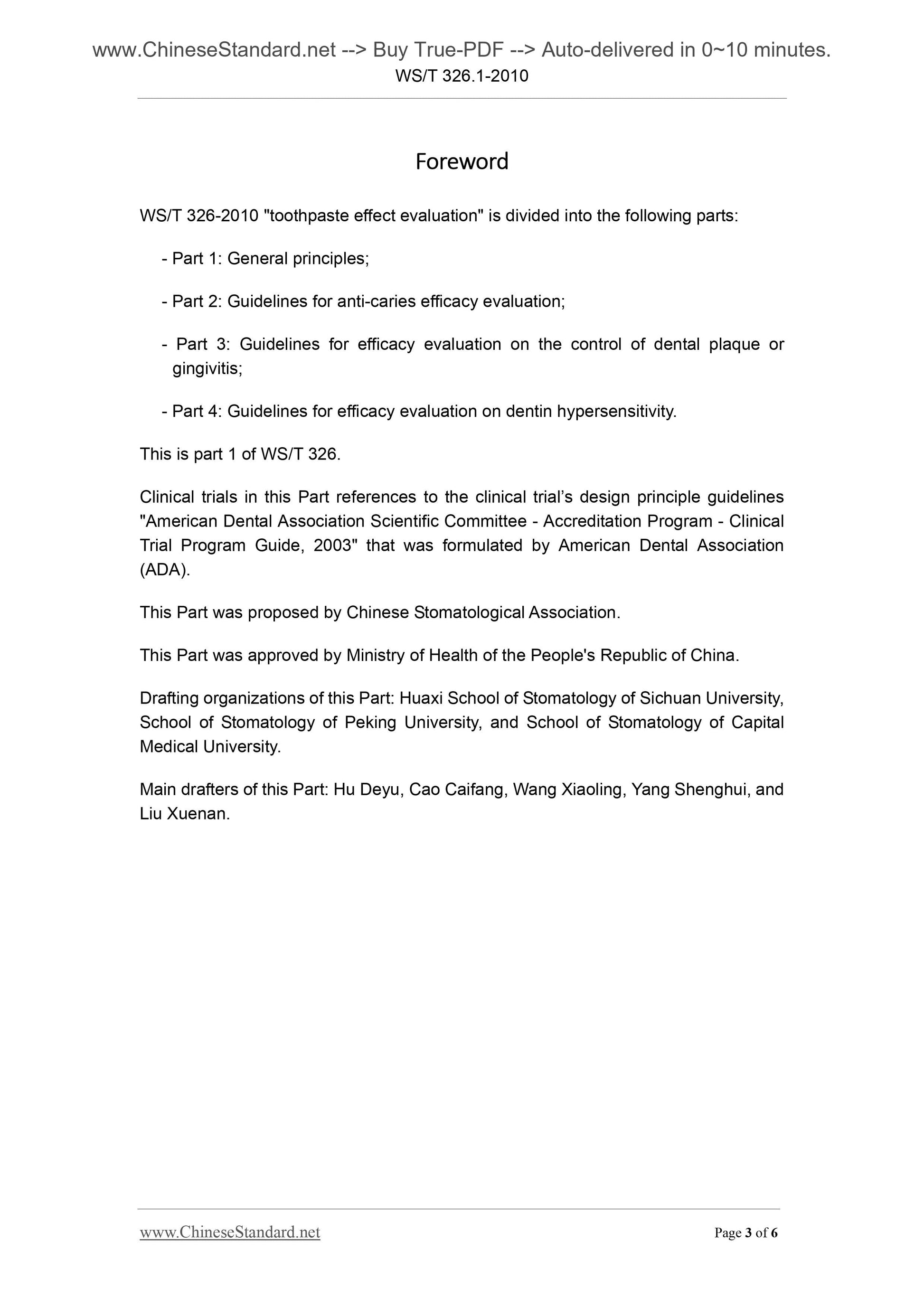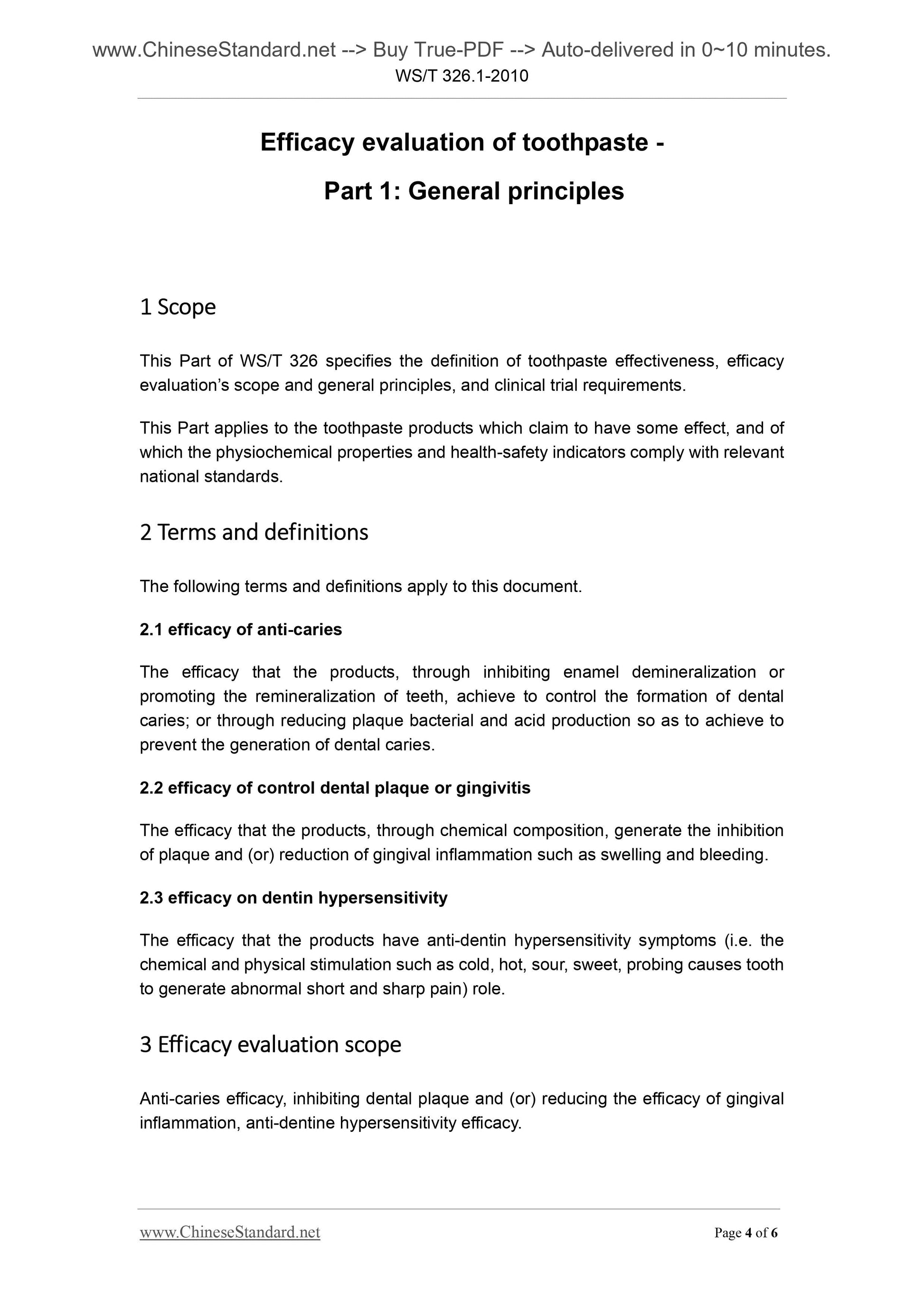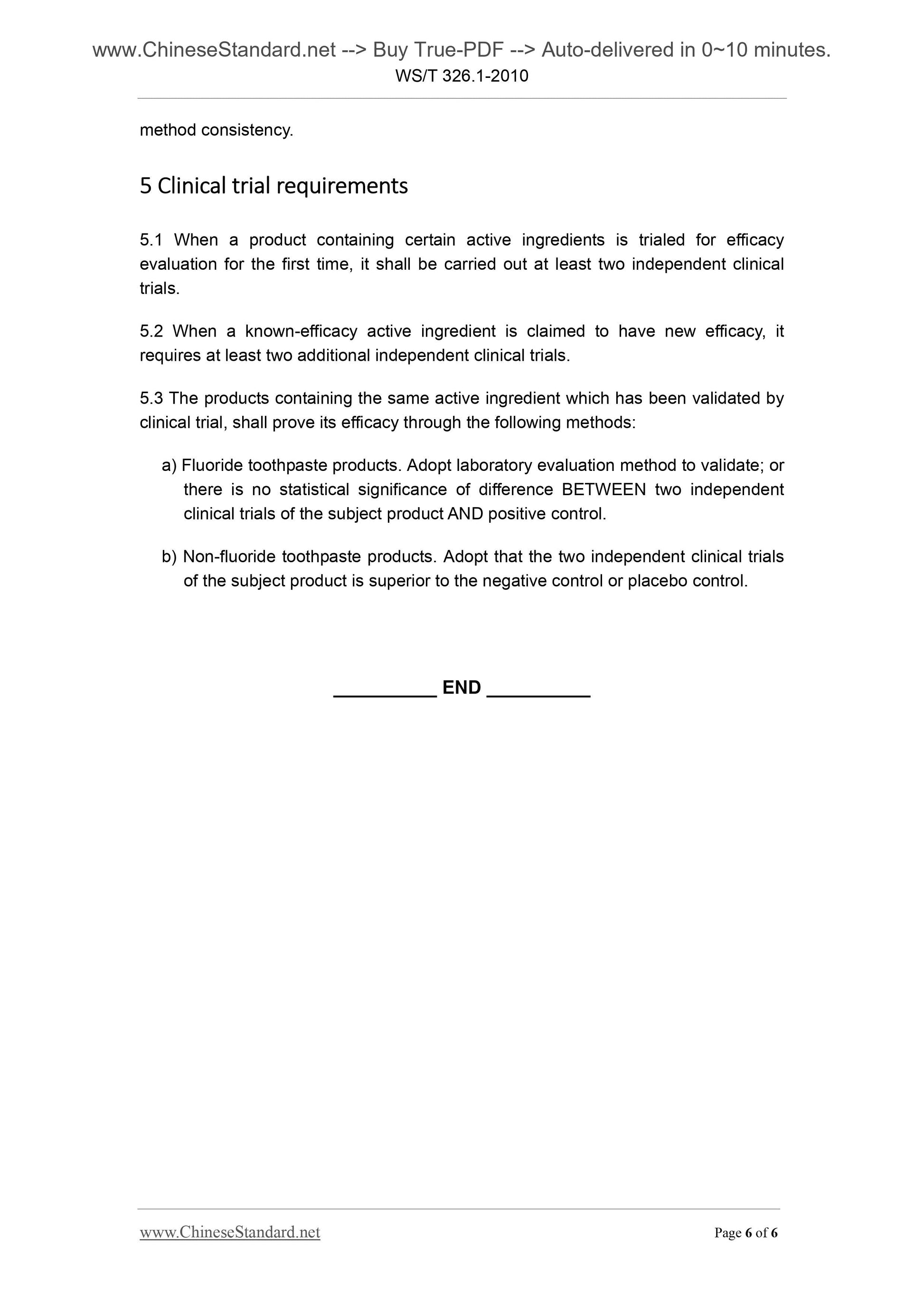1
/
จาก
5
PayPal, credit cards. Download editable-PDF and invoice in 1 second!
WS/T 326.1-2010 English PDF (WST326.1-2010)
WS/T 326.1-2010 English PDF (WST326.1-2010)
ราคาปกติ
$105.00 USD
ราคาปกติ
ราคาโปรโมชัน
$105.00 USD
ราคาต่อหน่วย
/
ต่อ
ค่าจัดส่งที่คำนวณในขั้นตอนการชำระเงิน
ไม่สามารถโหลดความพร้อมในการรับสินค้าด้วยตนเองได้
Delivery: 3 seconds. Download true-PDF + Invoice.
Get QUOTATION in 1-minute: Click WS/T 326.1-2010
Historical versions: WS/T 326.1-2010
Preview True-PDF (Reload/Scroll if blank)
WS/T 326.1-2010: Efficacy evaluation of toothpaste - Part 1: General principles
WS/T 326.1-2010
WS
HEALTH INDUSTRY STANDARD OF THE
PEOPLE’S REPUBLIC OF CHINA
ICS 11.020
C 05
Efficacy evaluation of toothpaste -
Part 1. General principles
ISSUED ON. DECEMBER 3, 2010
IMPLEMENTED ON. DECEMBER 3, 2010
Issued by. Ministry of Health of the People’s Republic of China
Table of Contents
Foreword ... 3
1 Scope ... 4
2 Terms and definitions ... 4
3 Efficacy evaluation scope... 4
4 General principles of efficacy evaluation ... 5
5 Clinical trial requirements ... 6
Foreword
WS/T 326-2010 "toothpaste effect evaluation" is divided into the following parts.
- Part 1. General principles;
- Part 2. Guidelines for anti-caries efficacy evaluation;
- Part 3. Guidelines for efficacy evaluation on the control of dental plaque or
gingivitis;
- Part 4. Guidelines for efficacy evaluation on dentin hypersensitivity.
This is part 1 of WS/T 326.
Clinical trials in this Part references to the clinical trial’s design principle guidelines
"American Dental Association Scientific Committee - Accreditation Program - Clinical
Trial Program Guide, 2003" that was formulated by American Dental Association
(ADA).
This Part was proposed by Chinese Stomatological Association.
This Part was approved by Ministry of Health of the People's Republic of China.
Drafting organizations of this Part. Huaxi School of Stomatology of Sichuan University,
School of Stomatology of Peking University, and School of Stomatology of Capital
Medical University.
Main drafters of this Part. Hu Deyu, Cao Caifang, Wang Xiaoling, Yang Shenghui, and
Liu Xuenan.
Efficacy evaluation of toothpaste -
Part 1. General principles
1 Scope
This Part of WS/T 326 specifies the definition of toothpaste effectiveness, efficacy
evaluation’s scope and general principles, and clinical trial requirements.
This Part applies to the toothpaste products which claim to have some effect, and of
which the physiochemical properties and health-safety indicators comply with relevant
national standards.
2 Terms and definitions
The following terms and definitions apply to this document.
2.1 efficacy of anti-caries
The efficacy that the products, through inhibiting enamel demineralization or
promoting the remineralization of teeth, achieve to control the formation of dental
caries; or through reducing plaque bacterial and acid production so as to achieve to
prevent the generation of dental caries.
2.2 efficacy of control dental plaque or gingivitis
The efficacy that the products, through chemical composition, generate the inhibition
of plaque and (or) reduction of gingival inflammation such as swelling and bleeding.
2.3 efficacy on dentin hypersensitivity
The efficacy that the products have anti-dentin hypersensitivity symptoms (i.e. the
chemical and physical stimulation such as cold, hot, sour, sweet, probing causes tooth
to generate abnormal short and sharp pain) role.
3 Efficacy evaluation scope
Anti-caries efficacy, inhibiting dental plaque and (or) reducing the efficacy of gingival
inflammation, anti-dentine hypersensitivity efficacy.
method consistency.
5 Clinical trial requirements
5.1 When a product containing certain active ingredients is trialed for efficacy
evaluation for the first time, it shall be carried out at least two independent clinical
trials.
5.2 When a known-efficacy active ingredient is claimed to have new efficacy, it
requires at least two additional independent clinical trials.
5.3 The products containing the same active ingredient which has been validated by
clinical trial, shall prove its efficacy through the following methods.
a) Fluoride toothpaste products. Adopt laboratory evaluation method to validate; or
there is no statistical significance of difference BETWEEN two independent
clinical trials of the subject product AND positive control.
b) Non-fluoride toothpaste products. Adopt that the two independent clinical trials
of the subject product is superior to the negative control or placebo control.
Get QUOTATION in 1-minute: Click WS/T 326.1-2010
Historical versions: WS/T 326.1-2010
Preview True-PDF (Reload/Scroll if blank)
WS/T 326.1-2010: Efficacy evaluation of toothpaste - Part 1: General principles
WS/T 326.1-2010
WS
HEALTH INDUSTRY STANDARD OF THE
PEOPLE’S REPUBLIC OF CHINA
ICS 11.020
C 05
Efficacy evaluation of toothpaste -
Part 1. General principles
ISSUED ON. DECEMBER 3, 2010
IMPLEMENTED ON. DECEMBER 3, 2010
Issued by. Ministry of Health of the People’s Republic of China
Table of Contents
Foreword ... 3
1 Scope ... 4
2 Terms and definitions ... 4
3 Efficacy evaluation scope... 4
4 General principles of efficacy evaluation ... 5
5 Clinical trial requirements ... 6
Foreword
WS/T 326-2010 "toothpaste effect evaluation" is divided into the following parts.
- Part 1. General principles;
- Part 2. Guidelines for anti-caries efficacy evaluation;
- Part 3. Guidelines for efficacy evaluation on the control of dental plaque or
gingivitis;
- Part 4. Guidelines for efficacy evaluation on dentin hypersensitivity.
This is part 1 of WS/T 326.
Clinical trials in this Part references to the clinical trial’s design principle guidelines
"American Dental Association Scientific Committee - Accreditation Program - Clinical
Trial Program Guide, 2003" that was formulated by American Dental Association
(ADA).
This Part was proposed by Chinese Stomatological Association.
This Part was approved by Ministry of Health of the People's Republic of China.
Drafting organizations of this Part. Huaxi School of Stomatology of Sichuan University,
School of Stomatology of Peking University, and School of Stomatology of Capital
Medical University.
Main drafters of this Part. Hu Deyu, Cao Caifang, Wang Xiaoling, Yang Shenghui, and
Liu Xuenan.
Efficacy evaluation of toothpaste -
Part 1. General principles
1 Scope
This Part of WS/T 326 specifies the definition of toothpaste effectiveness, efficacy
evaluation’s scope and general principles, and clinical trial requirements.
This Part applies to the toothpaste products which claim to have some effect, and of
which the physiochemical properties and health-safety indicators comply with relevant
national standards.
2 Terms and definitions
The following terms and definitions apply to this document.
2.1 efficacy of anti-caries
The efficacy that the products, through inhibiting enamel demineralization or
promoting the remineralization of teeth, achieve to control the formation of dental
caries; or through reducing plaque bacterial and acid production so as to achieve to
prevent the generation of dental caries.
2.2 efficacy of control dental plaque or gingivitis
The efficacy that the products, through chemical composition, generate the inhibition
of plaque and (or) reduction of gingival inflammation such as swelling and bleeding.
2.3 efficacy on dentin hypersensitivity
The efficacy that the products have anti-dentin hypersensitivity symptoms (i.e. the
chemical and physical stimulation such as cold, hot, sour, sweet, probing causes tooth
to generate abnormal short and sharp pain) role.
3 Efficacy evaluation scope
Anti-caries efficacy, inhibiting dental plaque and (or) reducing the efficacy of gingival
inflammation, anti-dentine hypersensitivity efficacy.
method consistency.
5 Clinical trial requirements
5.1 When a product containing certain active ingredients is trialed for efficacy
evaluation for the first time, it shall be carried out at least two independent clinical
trials.
5.2 When a known-efficacy active ingredient is claimed to have new efficacy, it
requires at least two additional independent clinical trials.
5.3 The products containing the same active ingredient which has been validated by
clinical trial, shall prove its efficacy through the following methods.
a) Fluoride toothpaste products. Adopt laboratory evaluation method to validate; or
there is no statistical significance of difference BETWEEN two independent
clinical trials of the subject product AND positive control.
b) Non-fluoride toothpaste products. Adopt that the two independent clinical trials
of the subject product is superior to the negative control or placebo control.
Share
